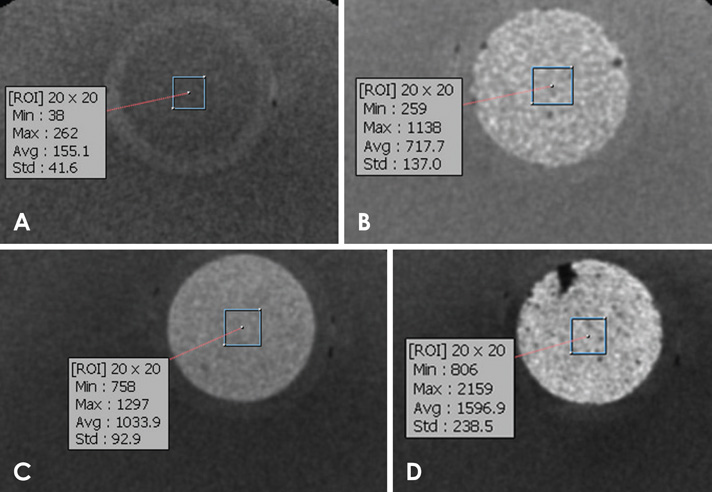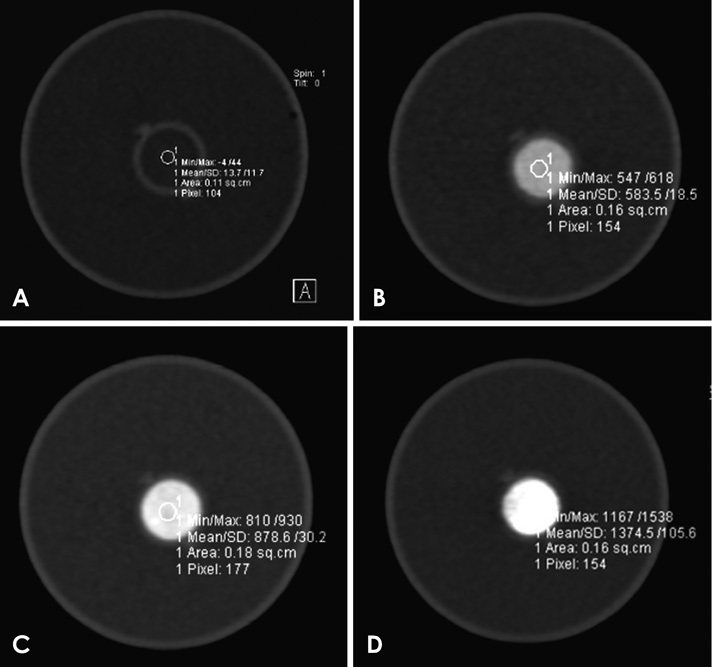Imaging Sci Dent.
2018 Mar;48(1):31-39. 10.5624/isd.2018.48.1.31.
Effect of field-of-view size on gray values derived from cone-beam computed tomography compared with the Hounsfield unit values from multidetector computed tomography scans
- Affiliations
-
- 1Dental Implant Research Center, Department of Oral and Maxillofacial Radiology, Faculty of Dentistry, Hamadan University of Medical Sciences, Hamadan, Iran. Hamedandleila@gmail.com
- 2Department of Periodontics, Faculty of Dentistry, Hamadan University of Medical Sciences, Hamadan, Iran.
- 3Molecular Research Center, Research Institute for Endocrine Sciences, Shahid Beheshti University of Medical Sciences, Tehran, Iran.
- 4Department of Radiology, Faculty of Para Medicine, Hamadan University of Medical Sciences, Hamadan, Iran.
- 5Department of Oral and Maxillofacial Radiology, Faculty of Dentistry, Hamadan University of Medical Sciences, Hamadan, Iran.
- KMID: 2406980
- DOI: http://doi.org/10.5624/isd.2018.48.1.31
Abstract
- PURPOSE
This study aimed to evaluate the effect of field-of-view (FOV) size on the gray values derived from conebeam computed tomography (CBCT) compared with the Hounsfield unit values from multidetector computed tomography (MDCT) scans as the gold standard.
MATERIALS AND METHODS
A radiographic phantom was designed with 4 acrylic cylinders. One cylinder was filled with distilled water, and the other 3 were filled with 3 types of bone substitute: namely, Nanobone, Cenobone, and Cerabone. The phantom was scanned with 2 CBCT systems using 2 different FOV sizes, and 1 MDCT system was used as the gold standard. The mean gray values (MGVs) of each cylinder were calculated in each imaging protocol.
RESULTS
In both CBCT systems, significant differences were noted in the MGVs of all materials between the 2 FOV sizes (P < .05) except for Cerabone in the Cranex3D system. Significant differences were found in the MGVs of each material compared with the others in both FOV sizes for each CBCT system. No significant difference was seen between the Cranex3D CBCT system and the MDCT system in the MGVs of bone substitutes on images obtained with a small FOV.
CONCLUSION
The size of the FOV significantly changed the MGVs of all bone substitutes, except for Cerabone in the Cranex3D system. Both CBCT systems had the ability to distinguish the 3 types of bone substitutes based on a comparison of their MGVs. The Cranex3D CBCT system used with a small FOV had a significant correlation with MDCT results.
MeSH Terms
Figure
Reference
-
1. Machado GL. CBCT imaging - a boon to orthodontics. Saudi Dent J. 2015; 27:12–21.
Article2. Eskandarloo A, Mirshekari A, Poorolajal J, Mohammadi Z, Shokri A. Comparison of cone-beam computed tomography with intraoral photostimulable phosphor imaging plate for diagnosis of endodontic complications: a simulation study. Oral Surg Oral Med Oral Pathol Oral Radiol. 2012; 114:e54–e61.
Article3. Shokri A, Mortazavi H, Salemi F, Javadian A, Bakhtiari H, Matlabi H. Diagnosis of simulated external root resorption using conventional intraoral film radiography, CCD, PSP, and CBCT: a comparison study. Biomed J. 2013; 36:18–22.
Article4. Shokri A, Khajeh S, Khavid A. Evaluation of the accuracy of linear measurements on lateral cephalograms obtained from cone-beam computed tomography scans with digital lateral cephalometric radiography: an in vitro study. J Craniofac Surg. 2014; 25:1710–1713.5. Almog DM, Romano PR. CT-based dental imaging for implant planning and surgical guidance. N Y State Dent J. 2007; 73:51–53.6. Mah J, Hatcher D. Three-dimensional craniofacial imaging. Am J Orthod Dentofacial Orthop. 2004; 126:308–309.
Article7. White S, Pharoah M. Oral radiology: principles and interpretation. 7th ed. St. Louis: Elsevier;2014.8. Shapurian T, Damoulis PD, Reiser GM, Griffin TJ, Rand WM. Quantitative evaluation of bone density using the Hounsfield index. Int J Oral Maxillofac Implants. 2006; 21:290–297.9. Norton MR, Gamble C. Bone classification: an objective scale of bone density using the computerized tomography scan. Clin Oral Implants Res. 2001; 12:79–84.
Article10. Rodrigues AF, Campos MJ, Chaoubah A, Fraga MR, Farinazzo Vitral RW. Use of gray values in CBCT and MSCT images for determination of density: influence of variation of FOV size. Implant Dent. 2015; 24:155–159.11. Palomo JM, Rao PS, Hans MG. Influence of CBCT exposure conditions on radiation dose. Oral Surg Oral Med Oral Pathol Oral Radiol Endod. 2008; 105:773–782.
Article12. Eskandarloo A, Abdinian M, Salemi F, Hashemzadeh Z, Safaei M. Effect of object location on the density measurement in cone-beam computed tomography versus multislice computed tomography. Dent Res J (Isfahan). 2012; 9:Suppl 1. S81–S87.13. Mah P, Reeves TE, McDavid WD. Deriving Hounsfield units using grey levels in cone beam computed tomography. Dentomaxillofac Radiol. 2010; 39:323–335.
Article14. Silva IM, Freitas DQ, Ambrosano GM, Bóscolo FN, Almeida SM. Bone density: comparative evaluation of Hounsfield units in multislice and cone-beam computed tomography. Braz Oral Res. 2012; 26:550–556.
Article15. Parsa A, Ibrahim N, Hassan B, van der Stelt P, Wismeijer D. Bone quality evaluation at dental implant site using multislice CT, micro-CT, and cone beam CT. Clin Oral Implants Res. 2015; 26:e1–e7.
Article16. Pauwels R, Jacobs R, Singer SR, Mupparapu M. CBCT-based bone quality assessment: are Hounsfield units applicable? Dentomaxillofac Radiol. 2015; 44:20140238.
Article17. Ribeiro-Rotta RF, Pereira AC, Oliveira GH, Freire MC, Leles CR, Lindh C. An exploratory survey of diagnostic methods for bone quality assessment used by Brazilian dental implant specialists. J Oral Rehabil. 2010; 37:698–703.
Article18. Norton MR, Gamble C. Bone classification: an objective scale of bone density using the computerized tomography scan. Clin Oral Implants Res. 2001; 12:79–84.
Article19. Misch CE. Density of bone: effect on treatment plans, surgical approach, healing, and progressive bone loading. Int J Oral Implantol. 1990; 6:23–31.20. Rinkel J, Gerfault L, Estève F, Dinten JM. A new method for x-ray scatter correction: first assessment on a cone-beam CT experimental setup. Phys Med Biol. 2007; 52:4633–4652.
Article21. Bryant JA, Drage NA, Richmond S. Study of the scan uniformity from an i-CAT cone beam computed tomography dental imaging system. Dentomaxillofac Radiol. 2008; 37:365–374.
Article22. Katsumata A, Hirukawa A, Okumura S, Naitoh M, Fujishita M, Ariji E, et al. Relationship between density variability and imaging volume size in cone-beam computerized tomographic scanning of the maxillofacial region: an in vitro study. Oral Surg Oral Med Oral Pathol Oral Radiol Endod. 2009; 107:420–425.
Article23. Katsumata A, Hirukawa A, Okumura S, Naitoh M, Fujishita M, Ariji E, et al. Effects of image artifacts on gray-value density in limited-volume cone-beam computerized tomography. Oral Surg Oral Med Oral Pathol Oral Radiol Endod. 2007; 104:829–836.
Article24. Nackaerts O, Maes F, Yan H, Couto Souza P, Pauwels R, Jacobs R. Analysis of intensity variability in multislice and cone beam computed tomography. Clin Oral Implants Res. 2011; 22:873–879.
Article25. Santiago RC, de Paula FO, Fraga MR, Picorelli Assis NM, Vitral RW. Correlation between miniscrew stability and bone mineral density in orthodontic patients. Am J Orthod Dentofacial Orthop. 2009; 136:243–250.
Article26. Mahnken AH, Mühlenbruch G, Koos R, Das M, Pohl S, Stanzel S, et al. Influence of a small field-of-view size on the detection of coronary artery calcifications with MSCT: in vitro and in vivo study. Eur Radiol. 2006; 16:358–364.
Article27. Pauwels R, Nackaerts O, Bellaiche N, Stamatakis H, Tsiklakis K, Walker A, et al. Variability of dental cone beam CT grey values for density estimations. Br J Radiol. 2013; 86:20120135.
Article28. Codari M, de Faria Vasconcelos K, Ferreira Pinheiro Nicolielo L, Haiter Neto F, Jacobs R. Quantitative evaluation of metal artifacts using different CBCT devices, high-density materials and field of views. Clin Oral Implants Res. 2017; 28:1509–1514.
Article29. Sonya DA, Davies J, Ford NL. A comparison of cone-beam computed tomography image quality obtained in phantoms with different fields of view, voxel size, and angular rotation for iCAT NG. J Oral Maxillofac Radiol. 2016; 4:31–39.
Article30. Kim DG. Can dental cone beam computed tomography assess bone mineral density? J Bone Metab. 2014; 21:117–126.
Article31. Siltanen S, Kolehmainen V, Järvenpää S, Kaipio JP, Koistinen P, Lassas M, et al. Statistical inversion for medical x-ray tomography with few radiographs: I. General theory. Phys Med Biol. 2003; 48:1437–1463.
Article32. Bryant JA, Drage NA, Richmond S. Study of the scan uniformity from an i-CAT cone beam computed tomography dental imaging system. Dentomaxillofac Radiol. 2008; 37:365–374.
Article
- Full Text Links
- Actions
-
Cited
- CITED
-
- Close
- Share
- Similar articles
-
- Patient radiation dose and protection from cone-beam computed tomography
- Osteoporosis prediction from the mandible using cone-beam computed tomography
- Three-dimensional imaging modalities in endodontics
- Study for hounsfield units in computed tomogram with jaw lesion
- Validation and comparison of volume measurements using 1 multidetector computed tomography and 5 cone-beam computed tomography protocols: An in vitro study





